
Recent Posts
Our Address
Kuta EcoStay
12 Gang Lotring
Jl. Pantai Kuta, Kuta,
Kabupaten Badung,
Bali 80361, Indonesia
Kuta EcoStay is pleased to recommend
Whether you come and stay at Kuta EcoStay in order to check out the magnificent Balinese arts and handicrafts, to go shopping for great bargains, to go surfing or diving on the nearby reefs, to go hiking through paddies and over volcanic peaks, to go paragliding at the cliffs near Uluwatu or to visit the many unique cultural and religious sites on this Island of the Gods, there is something for you which should hit the right note.
Below is our list of the top 20 places to visit when staying at Kuta EcoStay. We can provide a roadmap but some of the longer uphill journeys are unsuitable for small engine rented motor bikes. We recommend a car and driver to take the stress out of these trips. Kuta EcoStay can arrange the car/driver package at competitive rates. Stay Green! Stay Safe! Stay Kuta EcoStay!
Download PDF file: Short version – 1 min to download | Long version – 4 mins to download
This cliff top temple isn’t for the faint hearted.
Pura Uluwatu is on a cliff top overlooking the crashing waves of the Indian Ocean in the southwest of the Nusa Dua peninsula. Popular at any time of day, but especially at sunset. Paragliding over the cliffs and reefs near Uluwatu in the dry season can also be arranged. Eating a seafood dinner outdoors on the golden sands at Jimbaran Beach afterwards is also popular if nowadays touristy and a little expensive.
Take the Bypass road south from Kuta to Nusa Dua from the airport junction. Pass the Bali Intercontinental Hotel and keep going to Pecatu crossroads, then past the Nyangnyang (surfing) reef. 45 mins – 1 hour drive from Kuta EcoStay.
A small inhabited island just off the southern end of Sanur beach renowned for its sea turtle hatcheries ( three types of turtle – green, cracked and scaled), but also renowned for one of Bali’s most sacred temples. Turtles are fast becoming the most endangered species so your visit to the island brings attention to the conservation effort and discourages eating turtles as a food delicacy. The fishermen on the island can benefit from the money you spend there and see that there’s an alternative to catching turtles for the food market. Visit the turtle rehabilitation centre too as well as the hatcheries. A good time to visit is during the Kuningan festival when the Sakenan temple festivities on the island are taking place. Remember sea turtles are able to live over 100 years so when you see a full grown sea turtle it may be older than you, and wiser! Protect our vulnerable planet!
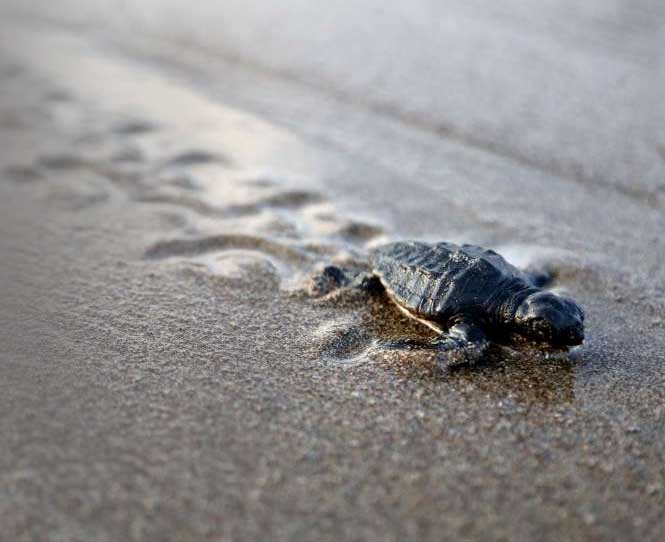
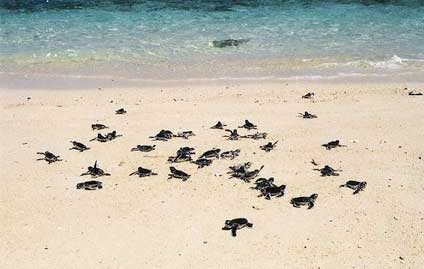
Take the Bypass road south from Kuta to Sanur . There is a causeway to drive out to the small island before you reach Sanur beach. Spacious parking and toilets. 45 mins – 1 hour drive from Kuta EcoStay. Of course you could just walk 500 m from Kuta EcoStay down Jln Raya Kuta to the main entrance to Kuta beach where there is a sea turtle hatchery on the left as you go through the main entrance. The hatchlings make an appearance around September when they are released for what ought to be a life lasting a century.
Why is this one of Bali’s most famous temples? Because at low tide you can walk there on a causeway and if timed right, enjoy the amazing ocean sunset too from this spectacular temple. Stop off at Echo (surfing) Beach in the up and coming Canggu area for an outdoor café meal by the surf where the surfing community hang out.
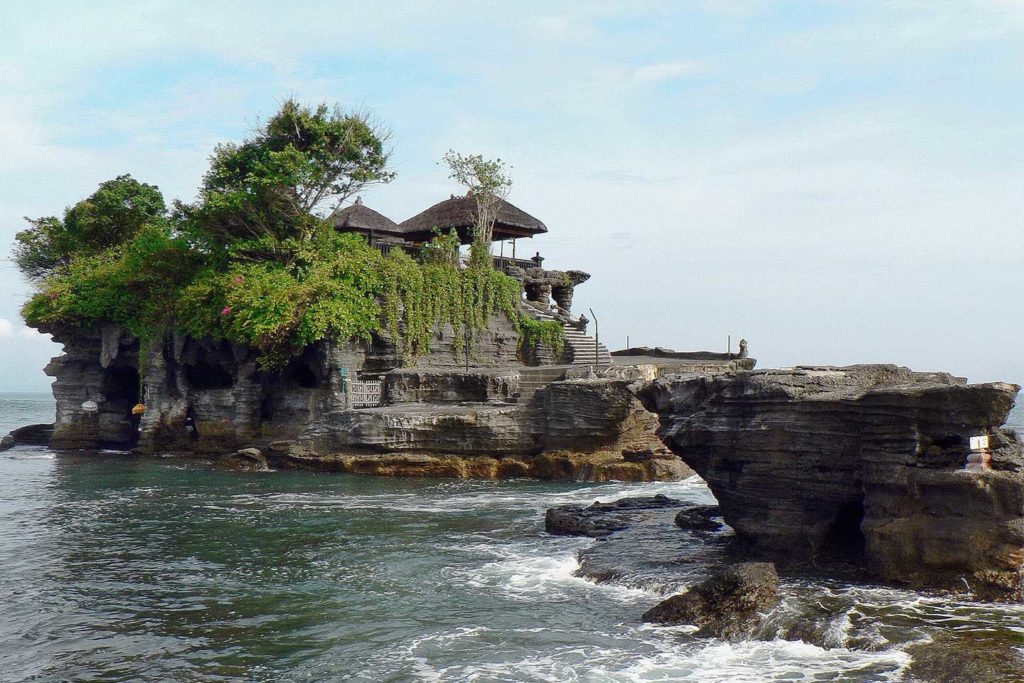
Take Jln Sunset west out of Kuta in direction of Seminyak. Then through Krobokan in the direction of the Nirwana Golf Club. Turn leH at Beraban for the coast and Tanah Lot. Journey time 1 – 1.5 hours drive since mostly slow single lane roads.
The museum used to be the home and studio of the impressionist Belgium painter Adrien Jean Le Mayeur de Merpres who arrived in Bali in the 1930’s, around the same time as other famous expatriate artists in Bali such as Spiess and Bonnet . Le Mayeur met and later married the famous legong dancer, Ni Polok, when she was 15. She modelled for many of his paintings that you can see in the museum. The house is set in a garden with beautiful frangipanis, Balinese statues and palm tree.
Museum entrance is along the beach in Sanur between Jln Hang Tuah and the (ugly) high rise Inna Grand Bali Beach hotel. The way in is a traditional Balinese entrance so keep your eyes open. Best go in the morning since on some afternoons it is shut. Theres a small souvenir shop to buy copies of Le Mayeur works.
The Bali Museum set in the beautiful surrounds of the former royal palace in the capital of Denpasar has on display amongst many exhibits theatrical masks, traditional musical instruments, Karangasem sculptures, paintings, textiles and archeological finds of the Bronze Age. Well worth a visit if you happen to be in Denpasar though Denpasar itself is busy, noisy and polluted, and in spite of Denpasar Moon not that noteworthy.
The museum is located on the east side of the central square of Denpasar, Taman Puputan. Journey time 45 mins1 hours drive from Kuta EcoStay since mostly busy roads into Den pasar.
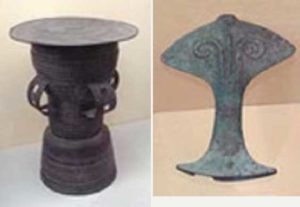
Stress out and have a fun day away from the traffic on the waterslides, of all shapes, sizes and lengths, at Waterbom. Not cheap but all our guests come back exhausted saying it was good value for money! Then up to the bamboo roof top bar at Kuta EcoStay to chill out as the sun sets and let the evening onshore breezes cool you down.
Walking distance from Kuta EcoStay. Turn leH as you step out of Kuta EcoStay, go down our gang 50m to Jln Tegal Wangi, turn right against the one way traffic and when you reach Kuta Art Market (aHer 300m) turn left onto Jln Kartika and its a short distance on the left hand side. 10 – 15 mins walk.
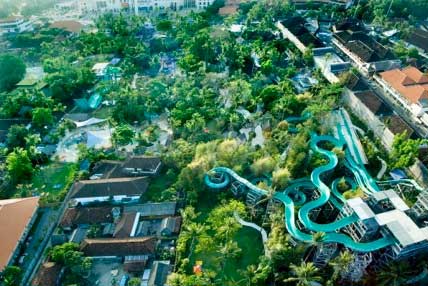
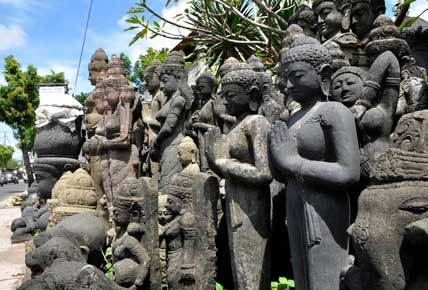
The whole village of Batubulan specialises in carving volcanic stone in various Balinese styles and sizes from small carvings to 3 metre high statues. Hard to carry away but can be freighted. A very unique and talented village! Allow up to 1 hour to get there from Kuta EcoStay.
Along the main road from Sanur to Ubud. Just under halfway from Kuta to Ubud. After Batubulan its not far along the same road to Celuk , then Mas, then Peliatan and then Ubud. All very interesting villages worth stopping at on the way to Ubud, the famous artists colony of Bali.
This village on the way to Ubud from Kuta holds the magical Barong and Kris dances every day of the year starting promptly at 9.30am. Always well frequented by tourists it pays to get in your seats at least 30 minutes early for a good view. The performances are riveting for young and old alike with a nice touch of humour. Not to be missed if a little touristy!
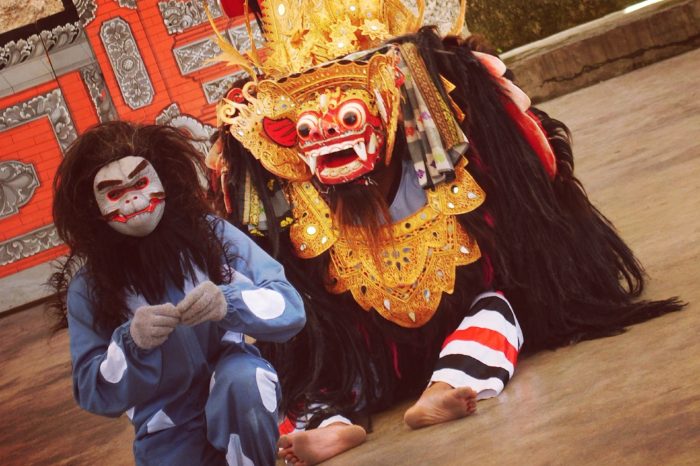
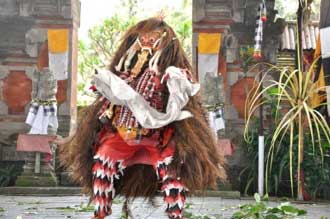
In the centre of Batubulan en route to Ubud. Allow upto 1 hour to get there from Kuta EcoStay plus arrive at least 30 minutes before the Barong show for the best seats. Many large tourist buses take the tourists there and then aHer the show go on to Celuk, Mas, Ubud etc. So best depart from the show before the tourist buses head off.
This village on the way to Ubud from Kuta is famous for silver (and some gold) jewellery, especially the highly detailed filigree silver jewelry. As is common in Bali any tourist guide/ driver that takes you into a shop will get the usual 10% commission on anything you buy. So look and don’t buy; and come back later without the guide/driver to save the 10%!
En route to Ubud from Sanur/Kuta. Allow upto 1 hour to get there from Kuta EcoStay. Afterwards go on to Mas, Ubud etc.
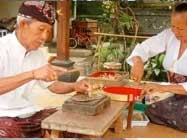
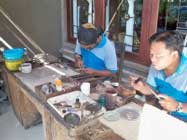
Balinese wood carvers have been influenced for centuries by traditional beliefs, myths and Hinduism. From 1920 – 30 onwards, wood carving developed into new modern styles influenced by expatriate artists such as Rudolf Bonnet, Walter Spies and Le Mayeur European artists who opened the minds of the Balinese artists beyond religious themes to include more freedom of expression and perspective. Bali wood carving is considered to be some of the finest wood carving in the world. It’s deep in Balinese culture, just look at the ornate hand carved wooden doors to any Balinese traditional home. Mas Village has its own unique style of wood carving art, best known for its carvings of female figures, Buddhas, characters from Hindu epic dramas and the traditional topeng (masks). The famous maestro who was born in this village is Ida Bagus Tilem. Tilem’s gallery is well worth stopping at though prices aren’t cheap.
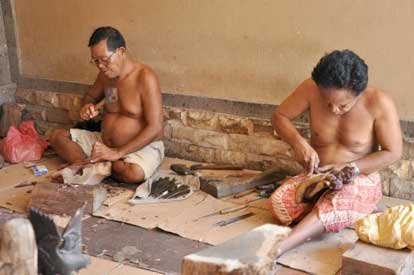
En route to Ubud from Sanur. Allow upto 1.5 hours to get there from Kuta EcoStay . Afterwards go on Ubud etc.
The artists community in the village of Penestanan has been producing its unique detailed watercolour paintings on canvas for almost a century with mentoring in the past from famous expatriate artists from Europe who lived there pre – war such as Rudolf Bonnet and Walter Spies. Prolific choices to select from and easy to take home since canvas using acrylic paints can be rolled up without any damage.
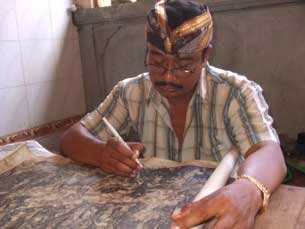
A few kilometres west of Ubud, aHer crossing the bridge at Campuan. Stop off for lunch at Murni’s at Campuan Bridge on the Ubud side. Murni has been serving food there at that spot for over 40 years.
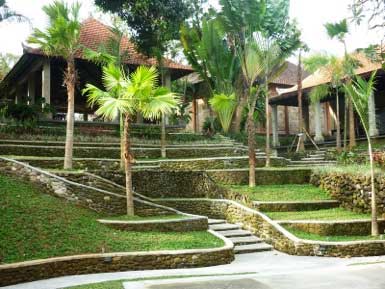
Ubud has always been a centre of Balinese painting and the Arts generally, including traditional Balinese dances. The village of Peliatan just before Ubud when you drive from Kuta EcoStay has one of the most famous dance troupes on the island. The art community has always gravitated to this beautiful part of Bali with its cooler climate in the hills. A lot to see and do in and around Ubud, if a little overcommercialised today. The Ubud Museum is a must to get a feel for how Ubud artist village was before its recent development phase.
The Ubud Museum is in the centre of Ubud just after the main crossroads, on the right hand side if driving north towards Campuan bridge.
Getting to Ubud by car from Kuta EcoStay will take about 1.5 – 2.5 hours direct without stopping. But in reality there are many interesting places on the way to Ubud, so relax and allow the whole day to reach Ubud. Best to stay overnight in Ubud. Kuta EcoStay can arrange a very nice inexpensive homestay on Jln Hanoman in Padangtegal at Jati’s Homestay (go to our Useful Links webpage and click Jati Homestay Bali) where you stay in the family compound of Dewa Nyoman Jati, a good friend and well known artist with his own studio in the compound overlooking the paddy fields. Highly recommended stopover with tariff prices similar to Kuta EcoStay. Make sure you say hi to Jati and visit his gallery of personal artworks in his compound. If you get up early say at 5.30am you’ll get to see him painting.
The best (private) Balinese art collection in magnificent traditional architectural surroundings with many separate gallery buildings. Go to Neka’s to see the best of the best and expect the prices, all in USD, to reflect so. The most valuable paintings on display are not for sale. Neka has a number of paintings by my good friend Dewa Nyoman Jati, but it’s much better value to buy direct from the artists at their studios. Paintings by most artists in Bali are in acrylic watercolours on canvas so easy to roll and carry. Neka’s tourist shop sells lovely art books with photographic quality plates of many of the most famous paintings in the art museum.
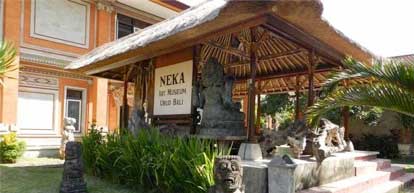
The Neka Art Museum is up the hill on the right, after crossing Campuan bridge, heading north out of Ubud. If you wanna bite then Murni’s restaurant overlooking the Campuan ravine, just before Campuan Bridge on the left when driving northwards, does excellent fare. Neka’s is just a few minutes drive uphill after you leave the centre of Ubud and cross Campuan Bridge, past the Campuan Hotel the original hotel in Ubud.
Just don’t buy any food for the monkeys; let the other tourists find out what happens to them! Just stand back and watch the fun when they feed the monkeys. Complete farce! Enjoy! These monkeys are also highly skilled pickpockets so buIon your pockets! This is a sacred monkey forest near the village of Padangtegal in Ubud.
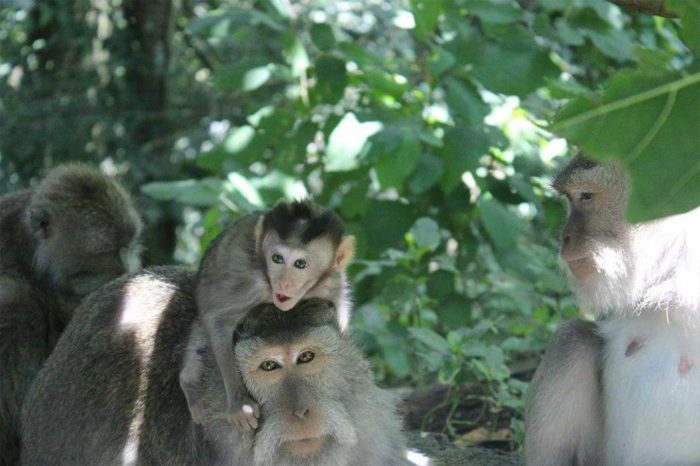
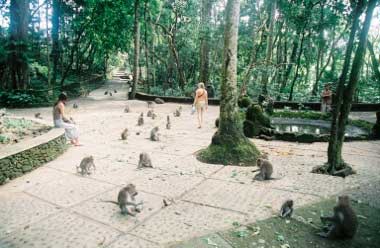
Go down Jln Hanoman which is on the left (when coming from Kuta) as you approach the centre of Ubud. Only a few kilometres away from the centre of Ubud.
Goa Gajah, or Elephant Cave, is located near Ubud. Built in the 9th century, it served as a hermit sanctuary. At the façade of the cave is a relief of an elephant, hence the name Elephant Cave. This cave is built at the confluence of the Pangkung and Petanu rivers to give it its magical energy.
Located near Ubud heading east to Bedulu in Blah Batuh sub district of the Gianyar Regency. It is about 27 km from Denpasar. From Ubud it’s a 30 minute drive.
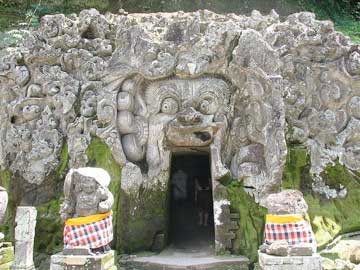
A walk to die for, leading to an 11th century Hindu temple complex, hermit caves and 7 metre high shrines (candi) carved into the sheer cliff face near the Pekerisan river . Wear good walking shoes since its an up and down pathway. It will take you 20 – 30 minutes to walk to the site from the parking area.
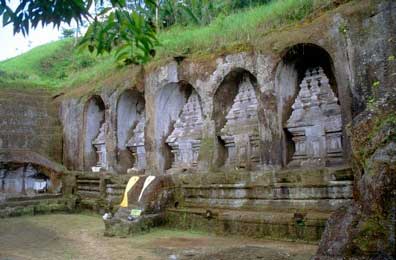
The monuments are hewn in relief on a solid rock hill. They are shaped like burial towers found all over Central and East Java . One very credible theory suggests the five temples in the main group were built for King Udayana and his eldest son Airlangga who ruled over East Java and over Bali from AD 1050 to 1077.
In the right of the main ensemble of temples is a cloister with five cells carved out of rock. The cloister inmates most likely were caretakers of the temple. There’s a second hermitage near the main cloister, consisting of niches around a central courtyard, which might have served as sleeping quarters for visiting pilgrims.
The temple complex is just outside Tampaksiring, north – east of Ubud. 1 hours drive from Ubud.
Tirtha Empul Temple is a holy water spring temple AD 920 with several bathing pools, in the vicinity of Tampaksiring village not far from Gunung Kawi, where Balinese regularly bathe as part of their religious rituals. Don’t forget to bring a sarong and sash, or hire when you reach the temple. You can also mandi ( bathe) in a sarong but separate areas for male and female. Purifying waters! Fine carvings in the courtyards. And fine bone carvings for sale.
40 kms north – east of Denpasar. 2.5 – 3 hours drive from Kuta EcoStay. Worth visiting Gunung Kawi on the way.
Worth the journey across the crater lake to discover one of a very few original animistic Bali villages. The village of Trunyan is squeezed between the far side of Lake Batur and the crater rim of the Mt Batur extinct volcano (height 1700 m). This is a Bali Aga village, inhabited by descendants of the original Balinese, who predate the arrival of the Majapahit Kingdom Hindus who came from Java in the 16th century as Islam was spreading across the archipelago. It is famous for the Pancering Jagat temple. There are also traditional Bali Aga dwellings and a large banyan tree said to be over 1,000 years old. Close to Trunyan is a unique cemetery. Unlike the current Balinese Hindus who cremate their dead, the people of Trunyan do not cremate, or bury, their dead, but just lay the remains out in bamboo cages to decompose. Interestingly there is no stench. A collection of skulls and bones lie nearby.
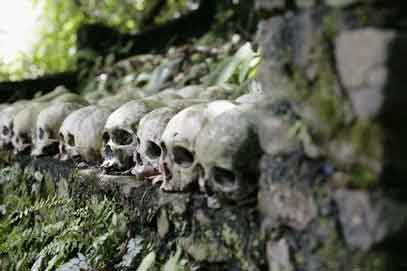
The village of Trunyan is situated on the far side of Lake Batur. This village is accessible only by boat from Toya Bungkah, and it takes around half an hour across the calm waters. Getting to Lake Batur (alt. 1000m) takes around 2 – 3 hours drive to the northeast from Kuta, along the main road to Penelokan and Kintamani. You can travel on to Singaraja, the original Dutch style capital where the likes of Charlie Chaplin and Bob Hope landed by cruise liner when visiting Bali back in the thirties.
From Singaraja you could make a round trip back to Kuta EcoStay via Gitgit waterfall and the twin lakes of Lake Buyan and Lake Bratan (alt. 1200m) through Wanagiri and Bedugul. At least an overnight round trip. Highly recommended!
Kintamani overlooks the volcano of Mount Batur and Lake Batur in the crater. Carry a jacket and be prepared for rain. The hawkers are a bit too pushy because of all the tourists there but the view is more than worth it. Good place to stop for lunch.
Getting to Kintamani takes around 2 – 3 hours drive to the northeast from Kuta, but probably longer given all the stops you will make on the way along the main road to Penelokan. Then on across the watershed to Singaraja.
From Singaraja you could make a round trip back to Kuta EcoStay via Gitgit waterfall and the twin lakes of Lake Buyan and Lake Bratan (alt. 1200m) through Wanagiri and Bedugul. At least an overnight round trip. Highly recommended!
Gitgit waterfall is located in a tropical rainforest and has a drop of about 35 meters and flows throughout the year. The waterfall has its own unique voice and is well worth a visit when in north Bali.
From Singaraja on the north coast you can travel to Gitgit waterfall in 45 mins, and thereafter on to the twin lakes of Lake Buyan and Lake Bratan (alt. 1200m) through Wanagiri and Bedugul which takes another 1hr drive.
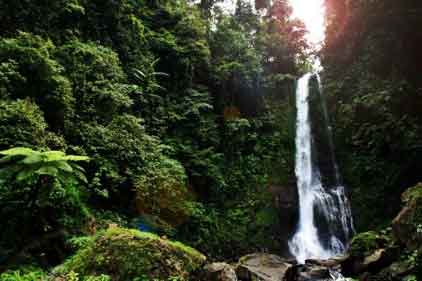
Don’t be disappointed not to be allowed into the sacred inner sanctum of the Mother Temple; there’s always ceremonies there to observe, on average every three days .The Mother Temple of Besakih on the volcanic slopes of sacred Mount Agung in north – east Bali is the most important, the largest and the holiest temple in Bali. The temple dates to the fourteenth century and is actually made up of 22 pura (temple buildings). A series of eruptions of Mount Agung (alt. 3200m) in 1963, which killed some 1,700 threatened the Mother Temple. The lava flows missed the Temple by mere meters. The saving of the Temple is regarded by the Balinese as miraculous and a signal from the Gods of their faith.
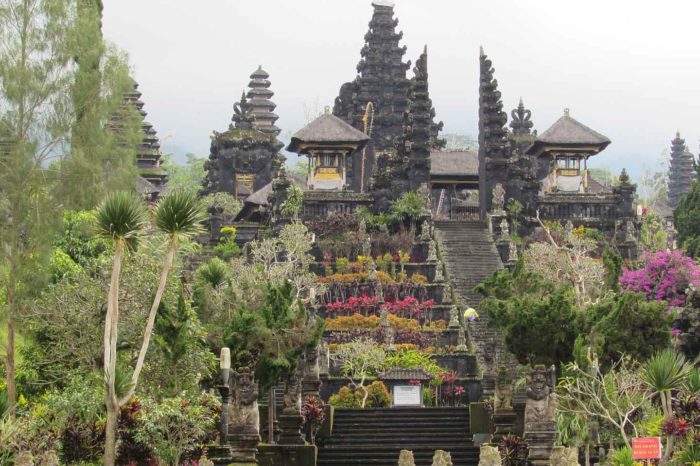
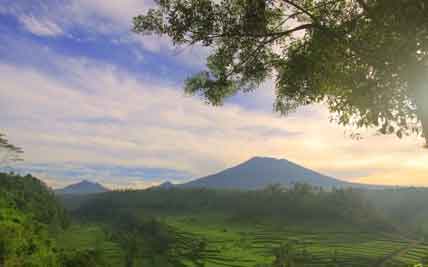
The Mother Temple of Besakih (alt. 1000m) on the slopes of Mount Agung is in north – east Bali. Via Gianyar and Bangli it will take 2.53 hours. BeIer via Semarapura ( Klungkung) and Bukit Jambu (great views!) and a bit quicker. Worth stopping in Klungkung also, where the traditional non – perspective art form of the Balinese originated. Klungkung art is not to everyone’s taste but well worth seeing so you beIer understand the origins of today’s Balinese art.
One of the few pre – Hindu Bali Aga villages still remaining in Bali, and the only one where they have perfected the highly prized technique of weaving geringsing, a rare double ikat textile found in only a few places in the world. Tenganan still holds to its original traditions and to the rules of the ancient Balinese, such as house design, religious rituals, intermarriage protocols and their way of life. Anyone who marries outside of the village has to leave. A strict protocol regarding marriages among kin groups have managed to steer the Tengananese through the genetic perils of intermarriage and the risks of infertility. In some ways however they are paying a high price in terms of lower birth fertility levels. Only those born in the village can stay in the village and become full members of the community.
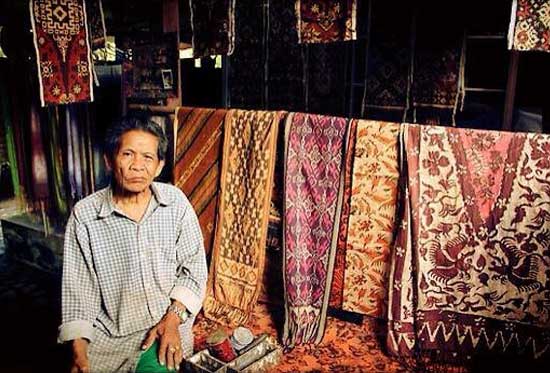
Many of the life – cycle rituals of the Tengananese are similar to those of the Balinese in general, but have some subtle differences. Some ceremonies are unique. One of the distinguishing features is the use of geringsing. By virtue of its magical qualities, geringsing is not only capable of keeping impurities and danger out of the village, but also shields and protects humans from evil influences during rites of passage as they transition from one phase of life to the next. The Tengananese receive their first geringsing at the hair cutting ritual. Hair is cut and placed in a basket which is placed on a folded geringsing on which the Tegananese both enter and leave the world. In the ceremony that admits a boy or girl to the youth association of the village, they are carried in a geringsing cloth on their father’s right shoulder. The youths wear a geringsing and carry a kris for the tooth filing ceremony, an essential rite of passage for all Balinese Hindus and the initiate’s pillow is covered by geringsing. After death the genitals of the deceased are covered by a geringsing hip sash. These cloths may not be used again and so usually are sold (for high prices since very rare and sought after). In the purification of the soul ceremony the deceased’s presence, which is symbolizes by an inscribed palm leaf, is also wrapped in geringsing. In the wedding ceremony the groom invites his in – laws to visit his parent’s home where the couple, dressed in geringsing cloth, receive symbolic gifts which are placed on geringsing cloth.
Take the coast road, after Sanur, east in the direction of Amlapura. Shortly before reaching Candi Desa, turn left and head north to Tenganan. 2.5 – 3 hours from Kuta EcoStay. Not visited by many tourists but really the heart of original Bali hinduism.
Tirta Gangga is a water palace in eastern Bali about 5 kilometres from Karangasem, owned by the Raja of Karangasem. Tirta Gangga literally means water from the Ganges and it is a sacred site for the Hindu Balinese. Tirta Gangga palace is a maze of pools and fountains, including an 11 tiered fountain, surrounded by lush gardens, stone carvings and statues. It has an air of authentic royal magnificence. The area north of Tirta Gangga is noted for its spectacular hillside rice paddy terraces.
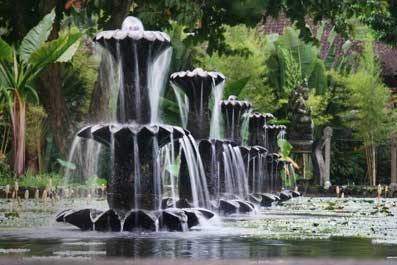
Tirta Gangga in eastern Bali is about 5 kilometres north from Karangasem ( aka Amlapura). About a 2.5 – 3 hour drive from Kuta EcoStay via the coast road bypassing Klungkung via the bat caves at Goa Lawah, past the turn – off to Tenganan Aga village and via Candi Dasa. A round trip along the north – east coast road would be an overnighter with the small town of Tejakula on the north coast being a suitable stop – over after visiting Tirta Gangga at midday.
when visiting temples and religious sites in Bali, adults have to show their respect by wearing a sarong and a waist sash. These can be rented when you pay the temple entrance fees, but you can also buy your own and carry it with you if you plan to visit several sacred sites.
And by the way menstruating women are not allowed into any Balinese sacred site. Be warned! Since there are many signs posted to remind you. But Ive never actually seen a woman being turned away!
Since you have reached the end of my Guide to the Top 20 Places to visit in Bali, you’ll have noticed it’s the top 23 places currently. This is a work in progress as I discover yet more and more about this magical Island of the Gods. Bali really is unique and all credit to the Balinese as they go about their daily rituals and have not allowed their culture and daily lives to be distorted by tourism!
Kuta EcoStay
12 Gang Lotring
Jl. Pantai Kuta, Kuta,
Kabupaten Badung,
Bali 80361, Indonesia
Kuta EcoStay
12 Gang Lotring
Jl. Pantai Kuta, Kuta,
Kabupaten Badung,
Bali 80361, Indonesia